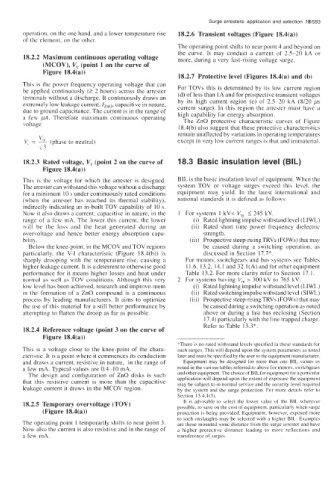Page 628 - Industrial Power Engineering and Applications Handbook
P. 628
Surge arresters: application and selection 18/593
operation, on the one hand, and a lower temperature rise 18.2.6 Transient voltages (Figure 18.4(a))
of the element, on the other.
The operating point shifts to near point 4 and beyond on
the curve. It may conduct a current of 2.5-20 kA or
18.2.2 Maximum continuous operating voltage more, during a very fast-rising voltage surge.
(MCOV), V, (point 1 on the curve of
Figure 18.4(a))
18.2.7 Protective level (Figures 18.4(a) and (h)
This IS the power frequency operating voltage that can For TOVs this is determined by its low current region
be applied continuously (2 2 hours) across the arrester (d) of less than 1A and for prospective transient voltages
terminals without a discharge. It continuously draws an
extremely low leakage current, IZnO, capacitive in nature, by its high current region (e) of 2.5-20 kA (8/20 ,us
due to ground capacitance. The current 15 in the range of current surge). In this region the arrester must have a
high capability for energy absorption.
a few ,LA. Therefore maximum continuous operating
voltage The ZnO protective characteristic curves of Figure
18.4(b) also suggest that these protective characteristics
remain unaffected by variations in operating temperatures
VI,,
V, = - (phase to neutral) except in very low current ranges is that and immaterial.
L3
18.2.3 Rated voltage, V, (point 2 on the curve of 18.3 Basic insulation level (BIL)
Figure 18.4(a))
This is the voltage for which the arrester is designed. BIL is the basic insulation level of equipment. When the
The arrester can withstand this voltage without a discharge system TOV or voltage surges exceed this level. the
for a minimum 10 s under continuously rated conditions equipment may yield. In the latest international and
(when the arrester has reached its thermal stability), national standards it is defined as follows:
indirectly indicating an in-built TOV capability of 10 s.
Now it also draws a current, capacitive in nature, in the 1 For systems 1 kV< V,, 5 245 kV.
range of a few mA. The lower this current, the lower (i) Rated lightning impulse withstand level (LIWL)
will be the loss and the heat generated during an (ii) Rated short time power frequency dielectric
overvoltage and hence better energy absorption capa- strength.
bili tj. (iii) Prospective steep-rising TRVs (FOWs) that may
Below the knee-point, in the MCOV and TOV regions be caused during a switching operation, as
particularly, the V-I characteristic (Figure 18.4(b)) is discussed in Section 17.7*.
sharply drooping with the temperature rise, causing a For motors, switchgears and bus systems see Tables
higher leakage current. It is a deterrent to otherwise good 11.6, 13.2, 14.1 and 32.1 (A) and for other equipment
performance for it means higher losses and heat under Table 13.2. For more clarity refer to Section 17.1.
normal as well as TOV conditions. Although this very 2 For systems having V, > 300 kV to 765 kV:
low level has been achieved, research and improve-ment (i) Rated lightning impulse withstand level (LIWL)
in the formation of a ZnO compound is a continuous (ii) Rated switchingimpulsewithstand level (SIWL)
process by leading manufacturers. It aims to optimize (iii) Prospective steep-rising TRVs (FOWs) that may
the use of this material for a still better performance by be caused during a switching operation as noted
attempting to flatten the droop as far as possible. above or during a fast bus reclosing (Section
17.4) particularly with the line trapped charge.
Refer to Table 13.3".
18.2.4 Reference voltage (point 3 on the curve of
Figure 18.4(a))
*There is no rated withstand levels specified in these standards for
This is a voltage close to the knee-point of the chara- such surges. This will depend upon the system parameters as noted
cteristic. It is a point where it commences its conduction later and must be specified by the user to the equipment manufacturer.
and draws a current, resistive in nature, in the range of Equipment may he designed for more than one BIL values as
a few mA. Typical values are 0.4-10 mA. noted in the various tables referred to above for motors, switchgears
The design and configuration of ZnO disks is such and other equipment. The choice of BIL for equipment for a particular
that this resistive current is more than the capacitive application will depend upon the extent of exposure the equipment
may be subject to in normal service and the security level required
leakage current it draws in the MCOV region. by the system and the surge protection. For more details refer to
Section 13.4.1(3).
18.2.5 Temporary overvoltage (TOV) It is advisable to select the lower value of the BIL wherever
(Figure 18.4(a)) possible, to save on the cost of equipment, particularly when surge
protection is being provided. Equipment, however, exposed more
to such onslaughts may he selected with a higher BIL. Examples
The operating point 1 temporarily shifts to near point 3. are those mounted some distance from the surge arrester and have
Now also the current is also resistive and in the range of a higher protective distance leading to more reflections and
a few mA. transference of surges.

